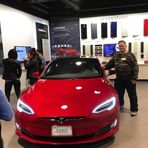Tesla's Loyalty Crisis: Politics, Competition, and a Shifting EV Landscape
August 5, 2025, 10:33 pm

Location: United States, Texas, Austin
Employees: 10001+
Founded date: 2003
Total raised: $3.86B
Tesla's once-unrivaled brand loyalty has dramatically collapsed. Exclusive data links this sharp decline directly to CEO Elon Musk's high-profile political endorsements. Customer loyalty peaked at 73% in June 2024, then plunged to a low of 49.9% by March. While recovering to 57.4%, Tesla now trails competitors like Toyota and Ford. Global sales are down significantly. An aging product line and intensified electric vehicle market competition exacerbate the issue. This unprecedented customer defection underscores a major brand challenge. Despite long-term hopes for robotaxis and autonomous driving, Tesla faces immediate pressures in retaining its core demographic and attracting new buyers.
Tesla once dominated. It held unrivaled customer loyalty in the automotive industry. That era appears over. New data reveals a drastic decline in repeat buyers. This unprecedented plunge follows CEO Elon Musk's deepening political involvement.
S&P Global Mobility data confirms the shift. Tesla’s customer loyalty peaked in June 2024. A staggering 73% of Tesla owners purchased another Tesla. This was an industry best. The loyalty rate plummeted in July 2024. This coincided with Musk’s endorsement of former President Donald Trump.
The decline was swift. By March, loyalty hit 49.9%. This placed Tesla below the industry average. It was a dramatic fall from its prior heights. The rate has since ticked up slightly to 57.4% in May. It now sits just above the industry average. Yet, it lags behind established rivals like Toyota, Chevrolet, and Ford. Such a rapid drop is extraordinary. It challenges established market trends.
Musk’s political actions are a clear factor. His endorsement of Trump and subsequent involvement in government initiatives alienated a key customer segment. Tesla’s customer base is often eco-conscious. Many hold Democratic leanings. Political alignment directly impacted their purchasing decisions. Brand perception suffered. Some customers now seek alternatives.
Competition intensifies daily. Tesla’s model lineup is aging. Its last significant new model arrived in 2020. The triangular Cybertruck launched, but sales disappoint. Legacy automakers now offer compelling electric vehicles. General Motors, Hyundai, and BMW actively compete. They chip away at Tesla’s market share. Chinese EV makers also pose a significant threat. The electric vehicle market is no longer a Tesla monopoly.
Overall sales reflect this downturn. Tesla vehicle sales are declining globally. U.S. sales fell 8% in the first five months of 2025. European sales saw a sharper drop. They plunged 33% over the first six months of the year. This suggests a widespread issue. Public backlash to Musk’s political stance is particularly fierce in Europe.
Customer defection is a major concern. Retaining existing customers is far more cost-effective than acquiring new ones. Tesla once excelled at attracting customers. For years, it gained nearly five new households for every one lost. This was unmatched. No other major brand came close. Hyundai’s Genesis brand was a distant second.
This advantage is eroding fast. Since July 2024, Tesla’s customer inflow has slowed. Since February, it gains fewer than two households for every one lost. This is Tesla’s lowest level ever. The net migration to Tesla is clearly slowing.
Former Tesla owners now consider other brands. Rivian attracts some. Polestar is another destination. Porsche and Cadillac also gain these customers. The EV market offers diverse, appealing choices. Tesla no longer holds unique appeal for many.
Some investors remain unfazed. They point to Tesla’s long-term vision. Robotaxis and self-driving technology represent massive future profit streams. A small robotaxi test launched in Austin in June. This service is not yet public. Proponents argue Tesla may not need to sell cars and trucks in the future. Their focus is software, not hardware.
However, immediate challenges persist. Tesla’s market share is shrinking. Brand damage needs repair. The company prioritized self-driving technology. This came at the expense of developing new, affordable models for human drivers. This strategic choice impacts sales today.
Tesla’s chief financial officer noted "unwarranted hostility" towards the brand. This highlights the palpable public sentiment. Lost production time also occurred. Factories retooled for a refreshed Model Y. Yet, these factors alone cannot explain the dramatic loyalty collapse.
The data speaks clearly. Tesla’s loyalty crisis is real. It stems from multiple factors. Leadership choices impact consumer trust. Market dynamics shift rapidly. Competition intensifies. Tesla faces a pivotal moment. Its future hinges on adapting to this new reality. Rebuilding trust and innovating its core product line are crucial steps. The EV pioneer must navigate a complex landscape to regain its once-dominant position. This includes addressing customer concerns head-on. The brand's reputation is on the line.
Tesla once dominated. It held unrivaled customer loyalty in the automotive industry. That era appears over. New data reveals a drastic decline in repeat buyers. This unprecedented plunge follows CEO Elon Musk's deepening political involvement.
S&P Global Mobility data confirms the shift. Tesla’s customer loyalty peaked in June 2024. A staggering 73% of Tesla owners purchased another Tesla. This was an industry best. The loyalty rate plummeted in July 2024. This coincided with Musk’s endorsement of former President Donald Trump.
The decline was swift. By March, loyalty hit 49.9%. This placed Tesla below the industry average. It was a dramatic fall from its prior heights. The rate has since ticked up slightly to 57.4% in May. It now sits just above the industry average. Yet, it lags behind established rivals like Toyota, Chevrolet, and Ford. Such a rapid drop is extraordinary. It challenges established market trends.
Musk’s political actions are a clear factor. His endorsement of Trump and subsequent involvement in government initiatives alienated a key customer segment. Tesla’s customer base is often eco-conscious. Many hold Democratic leanings. Political alignment directly impacted their purchasing decisions. Brand perception suffered. Some customers now seek alternatives.
Competition intensifies daily. Tesla’s model lineup is aging. Its last significant new model arrived in 2020. The triangular Cybertruck launched, but sales disappoint. Legacy automakers now offer compelling electric vehicles. General Motors, Hyundai, and BMW actively compete. They chip away at Tesla’s market share. Chinese EV makers also pose a significant threat. The electric vehicle market is no longer a Tesla monopoly.
Overall sales reflect this downturn. Tesla vehicle sales are declining globally. U.S. sales fell 8% in the first five months of 2025. European sales saw a sharper drop. They plunged 33% over the first six months of the year. This suggests a widespread issue. Public backlash to Musk’s political stance is particularly fierce in Europe.
Customer defection is a major concern. Retaining existing customers is far more cost-effective than acquiring new ones. Tesla once excelled at attracting customers. For years, it gained nearly five new households for every one lost. This was unmatched. No other major brand came close. Hyundai’s Genesis brand was a distant second.
This advantage is eroding fast. Since July 2024, Tesla’s customer inflow has slowed. Since February, it gains fewer than two households for every one lost. This is Tesla’s lowest level ever. The net migration to Tesla is clearly slowing.
Former Tesla owners now consider other brands. Rivian attracts some. Polestar is another destination. Porsche and Cadillac also gain these customers. The EV market offers diverse, appealing choices. Tesla no longer holds unique appeal for many.
Some investors remain unfazed. They point to Tesla’s long-term vision. Robotaxis and self-driving technology represent massive future profit streams. A small robotaxi test launched in Austin in June. This service is not yet public. Proponents argue Tesla may not need to sell cars and trucks in the future. Their focus is software, not hardware.
However, immediate challenges persist. Tesla’s market share is shrinking. Brand damage needs repair. The company prioritized self-driving technology. This came at the expense of developing new, affordable models for human drivers. This strategic choice impacts sales today.
Tesla’s chief financial officer noted "unwarranted hostility" towards the brand. This highlights the palpable public sentiment. Lost production time also occurred. Factories retooled for a refreshed Model Y. Yet, these factors alone cannot explain the dramatic loyalty collapse.
The data speaks clearly. Tesla’s loyalty crisis is real. It stems from multiple factors. Leadership choices impact consumer trust. Market dynamics shift rapidly. Competition intensifies. Tesla faces a pivotal moment. Its future hinges on adapting to this new reality. Rebuilding trust and innovating its core product line are crucial steps. The EV pioneer must navigate a complex landscape to regain its once-dominant position. This includes addressing customer concerns head-on. The brand's reputation is on the line.


